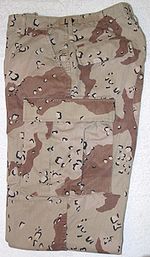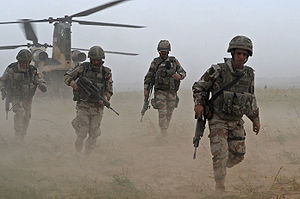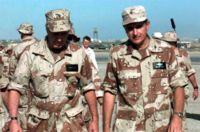
Chocolate-chip camouflage
Encyclopedia

Camouflage
Camouflage is a method of concealment that allows an otherwise visible animal, military vehicle, or other object to remain unnoticed, by blending with its environment. Examples include a leopard's spotted coat, the battledress of a modern soldier and a leaf-mimic butterfly...
used by the United States Military
Military of the United States
The United States Armed Forces are the military forces of the United States. They consist of the Army, Navy, Marine Corps, Air Force, and Coast Guard.The United States has a strong tradition of civilian control of the military...
during the Gulf War
Gulf War
The Persian Gulf War , commonly referred to as simply the Gulf War, was a war waged by a U.N.-authorized coalition force from 34 nations led by the United States, against Iraq in response to Iraq's invasion and annexation of Kuwait.The war is also known under other names, such as the First Gulf...
and in the early 1990s. The camouflage received its nickname because it resembles chocolate-chip
Chocolate chip
Chocolate chips are small chunks of chocolate. They are often sold in a round, flat-bottomed teardrop shape. They are available in numerous sizes, from large to miniature, but are usually around 1 cm in diameter.-Origin:...
cookie dough
Cookie dough
Cookie dough refers to a blend of cookie ingredients which has been mixed into a malleable form which has not yet been hardened by heat. The dough is often then separated and the portions baked to individual cookies, or eaten as is....
. It is made up of a base pattern of light tan overlaid with broad swathes of pale olive green and wide two-tone bands of brown. Clusters of black-on-white spots are scattered over it which were meant to mimic the appearance of rocks.
History
Although the chocolate-chip camouflage became well-known during the Gulf WarGulf War
The Persian Gulf War , commonly referred to as simply the Gulf War, was a war waged by a U.N.-authorized coalition force from 34 nations led by the United States, against Iraq in response to Iraq's invasion and annexation of Kuwait.The war is also known under other names, such as the First Gulf...
, it was originally designed in 1962. The Army, believing that it might become necessary to intervene in the Arab-Israeli conflicts, developed a test pattern using the deserts of southwestern United States
United States
The United States of America is a federal constitutional republic comprising fifty states and a federal district...
as a model. When the hostilities in the Middle East
Middle East
The Middle East is a region that encompasses Western Asia and Northern Africa. It is often used as a synonym for Near East, in opposition to Far East...
wound down, the test pattern was mothballed. The formation of the Rapid Deployment Force (RDF) in 1979, with its remit to operate in the Middle East, and protect U.S. interests in the Persian Gulf region, saw the need for desert camouflage clothing to emerge again.
Operational use
The six-color desert pattern entered service in 1981 at the same time as the woodland BDUs and would be worn in limited numbers by U.S. troops taking part in the biennial Bright StarOperation Bright Star
Operation Bright Star is a series of biennial combined and joint training exercises led by American and Egyptian forces in Egypt. These exercises began in 1980. They are designed to strengthen ties between the Egyptian and American militaries and demonstrate and enhance the ability of the Americans...
exercises in Egypt during the 1980s, and by FORSCOM peacekeepers assigned to the Multinational Force and Observers
Multinational Force and Observers
The Multinational Force and Observers is an international peacekeeping force overseeing the terms of the peace treaty between Egypt and Israel.-Background:...
in the Egyptian Sinai Desert, but issued in large numbers prior to the Gulf War
Gulf War
The Persian Gulf War , commonly referred to as simply the Gulf War, was a war waged by a U.N.-authorized coalition force from 34 nations led by the United States, against Iraq in response to Iraq's invasion and annexation of Kuwait.The war is also known under other names, such as the First Gulf...
. However, there is evidence that the six-color desert pattern camouflage was in use before 1981 with photographs of American military personnel involved in Operation Eagle Claw
Operation Eagle Claw
Operation Eagle Claw was an American military operation ordered by President Jimmy Carter to attempt to put an end to the Iran hostage crisis by rescuing 52 Americans held captive at the U.S. Embassy in Tehran, Iran on 24 April 1980...
in April 1980 using this camouflage pattern in the failed attempt to rescue US Embassy staff being held hostage Iran
Iran
Iran , officially the Islamic Republic of Iran , is a country in Southern and Western Asia. The name "Iran" has been in use natively since the Sassanian era and came into use internationally in 1935, before which the country was known to the Western world as Persia...
.
Feedback from these users indicated that the design contrasted too much with the terrain, preventing the camouflage from blending in effectively. Anecdotal evidence suggested that the dark areas of the pattern warmed up more than the paler parts under desert sunlight, and retained the heat longer. The six colors were also more expensive to manufacture than three or four colors, and the need for a camouflage that would be suitable for use in any desert resulted in a requirement for a new desert camouflage uniform. The U.S. Army Natick Soldier Center began the search for a substitute. Samples of sand and earth from the Middle East were measured for optical and infrared reflectance, and seven trial patterns were created using these statistics. The patterns were evaluated in fourteen different desert locations and narrowed down to one favourite. The resulting "Desert Camouflage Pattern: Combat" was standardized in 1990, but was not ready before troops deployed to Saudi Arabia
Saudi Arabia
The Kingdom of Saudi Arabia , commonly known in British English as Saudi Arabia and in Arabic as as-Sa‘ūdiyyah , is the largest state in Western Asia by land area, constituting the bulk of the Arabian Peninsula, and the second-largest in the Arab World...
during the Gulf War of 1990-1991. Consequently U.S. forces wore the six-color BDUs during the campaign. During that war, after initiatives by General Norman Schwarzkopf, the six-color Desert BDU was produced in 100% cotton poplin without reinforcement panels in order to improve comfort in hot desert conditions. A total of 500,000 improved cotton BDUs were ordered. However, cost concerns caused the cotton six-color Desert BDU to be discontinued shortly after the Gulf war.
Replacement desert pattern

Desert Camouflage Uniform
The Desert Camouflage Uniform is essentially the same as the United States military's Battle Dress Uniform uniform, only featuring the three-color desert camouflage pattern of light tan, pale green, and brown, as opposed to the dark green, black, brown, and dark tan of the BDU's woodland pattern...
(DCU) in 1993, consisted of a subtle blend of large pastel green and light tan shapes, with sparsely placed, narrow, reddish brown patches, leading the design to be unofficially nicknamed the “Coffee Stain” pattern.
Both patterns were briefly used together during the transition period, most notably during Operation Restore Hope and Operation Gothic Serpent
Operation Gothic Serpent
Operation Gothic Serpent was a military operation conducted by special operations forces of the United States with the primary mission of capturing warlord Mohamed Farrah Aidid...
(some U.S. Army Rangers during the latter occasionally wore the newer three-color DCU's along with kevlar helmet covers retaining the old six-color pattern). In the 2003 invasion of Iraq
2003 invasion of Iraq
The 2003 invasion of Iraq , was the start of the conflict known as the Iraq War, or Operation Iraqi Freedom, in which a combined force of troops from the United States, the United Kingdom, Australia and Poland invaded Iraq and toppled the regime of Saddam Hussein in 21 days of major combat operations...
, the U.S. Military used both the tri-color DCU and MARPAT
MARPAT
MARPAT is a digital camouflage pattern in use with the United States Marine Corps, introduced with the Marine Corps Combat Utility Uniform , which replaced the Camouflage Utility Uniform. The pattern is formed by a number of small rectangular pixels of color...
camouflage patterns.
Legacy
Even today the chocolate-chip pattern is still in use outside of the United States. A uniform similar to the Desert Battle Dress Uniform was issued to the Iraqi National Guard before it was dissolved in 2004 and other Iraqi security forces. South Korean forces have used, in limited numbers since 1993, a variant with brown replacing the black in the U.S. design; this Korean design has also been tested in the United Arab EmiratesUnited Arab Emirates
The United Arab Emirates, abbreviated as the UAE, or shortened to "the Emirates", is a state situated in the southeast of the Arabian Peninsula in Western Asia on the Persian Gulf, bordering Oman, and Saudi Arabia, and sharing sea borders with Iraq, Kuwait, Bahrain, Qatar, and Iran.The UAE is a...
. The National Guard of Oman
Oman
Oman , officially called the Sultanate of Oman , is an Arab state in southwest Asia on the southeast coast of the Arabian Peninsula. It is bordered by the United Arab Emirates to the northwest, Saudi Arabia to the west, and Yemen to the southwest. The coast is formed by the Arabian Sea on the...
wear a pattern mixing chocolate-chip with 'amoeba', while the National Guards of both Saudi Arabia
Saudi Arabia
The Kingdom of Saudi Arabia , commonly known in British English as Saudi Arabia and in Arabic as as-Sa‘ūdiyyah , is the largest state in Western Asia by land area, constituting the bulk of the Arabian Peninsula, and the second-largest in the Arab World...
and Kuwait
Kuwait
The State of Kuwait is a sovereign Arab state situated in the north-east of the Arabian Peninsula in Western Asia. It is bordered by Saudi Arabia to the south at Khafji, and Iraq to the north at Basra. It lies on the north-western shore of the Persian Gulf. The name Kuwait is derived from the...
use a grey variation on the chocolate-chip design. The Saudis also use a grey, black, and white 'urban' variation and the police wear a blue version of the same design; Palestinian
Palestinian National Authority
The Palestinian Authority is the administrative organization established to govern parts of the West Bank and Gaza Strip...
police also use a blue chocolate-chip patterned uniform. The South African "Soldier 2000" pattern is similar to the U.S. design. A copy of the pattern, using tan, medium brown, bottle-green and greyish green, in addition to the black-on-white pebbles, is used in Kazakhstan
Kazakhstan
Kazakhstan , officially the Republic of Kazakhstan, is a transcontinental country in Central Asia and Eastern Europe. Ranked as the ninth largest country in the world, it is also the world's largest landlocked country; its territory of is greater than Western Europe...
.
Users


See also
- Battle Dress UniformBattle Dress UniformThe Battle Dress Uniform were the fatigues that the armed forces of the United States used as their standard uniform for combat situations from September 1981 to April 2005. Since then, it has been replaced in every branch of the U.S. military. Only the U.S. Navy currently authorizes wear of the...
- Desert Camouflage UniformDesert Camouflage UniformThe Desert Camouflage Uniform is essentially the same as the United States military's Battle Dress Uniform uniform, only featuring the three-color desert camouflage pattern of light tan, pale green, and brown, as opposed to the dark green, black, brown, and dark tan of the BDU's woodland pattern...
- Desert Night CamouflageDesert Night CamouflageThe Desert Night Camouflage pattern is a two-color grid camouflage pattern used by the United States military during the Gulf War. It was designed to aid soldiers in concealment from older generation enemy night vision devices...
- Army Combat UniformArmy Combat UniformThe Army Combat Uniform is the current combat uniform worn by the United States Army. It is the successor to the Battle Dress Uniform and Desert Camouflage Uniform worn during the 1980s and 1990s. It features a number of design changes, as well as a different camouflage pattern from its...
- CamouflageCamouflageCamouflage is a method of concealment that allows an otherwise visible animal, military vehicle, or other object to remain unnoticed, by blending with its environment. Examples include a leopard's spotted coat, the battledress of a modern soldier and a leaf-mimic butterfly...
- Military camouflageMilitary camouflageMilitary camouflage is one of many means of deceiving an enemy. In practice, it is the application of colour and materials to battledress and military equipment to conceal them from visual observation. The French slang word camouflage came into common English usage during World War I when the...
- List of camouflage patterns
External links
- Army Regulation 670-1 "Wear and Appearance of Army Uniforms and Insignia"
- kamouflage.net > North America > United States of America > U.S. 3-color desert battle dress uniform camouflage
- kamouflage.net > North America > United States of America > U.S. 6-color desert camouflage
- Additional historical background

